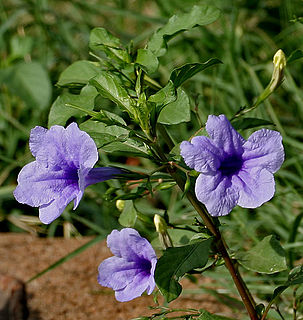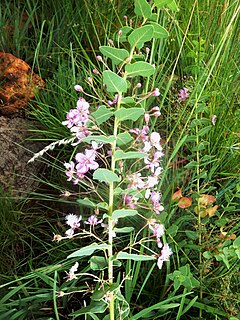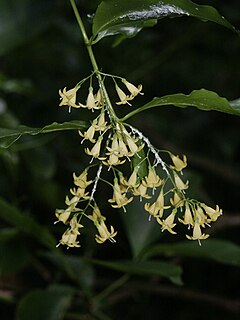
Flowering plants include multiple members of the clade Angiospermae, commonly called angiosperms. The term "angiosperm" is derived from the Greek words angeion and sperma ('seed'), and refers to those plants that produce their seeds enclosed within a fruit. They are the most diverse group of land plants with 64 orders, 416 families, approximately 13,000 known genera and 300,000 known species. Angiosperms were formerly called Magnoliophyta.

Sex is a trait that determines an individual's reproductive function, male or female, in animals and plants that propagate their species through sexual reproduction. The type of gametes produced by an organism define its sex. Commonly in plants and animals, male organisms produce smaller gametes while female organisms produce larger gametes. Organisms that produce both types of gametes are called hermaphrodites. During sexual reproduction, male and female gametes fuse to form zygotes that develop into offspring that inherit a selection of the traits of each parent.

Robert Anthony Plant is an English singer and songwriter, best known as the lead singer and lyricist of the English rock band Led Zeppelin for all of its existence from 1968 up until 1980, when the band broke up following the death of John Bonham, the band's drummer.

A perennial plant or simply perennial is a plant that lives more than two years. The term is often used to differentiate a plant from shorter-lived annuals and biennials. The term is also widely used to distinguish plants with little or no woody growth from trees and shrubs, which are also technically perennials.

Eucalyptus accedens, commonly known as smooth bark wandoo or powderbark wandoo is a species of tree endemic to the south-west of Western Australia. Although the common names suggest it is similar to wandoo,, the two species are very different botanically. The bark of E. accedens has talc-like powder, at least on the protected side of the trunk and the tree usually grows on laterite in higher places.

A flower, sometimes known as a bloom or blossom, is the reproductive structure found in flowering plants. The biological function of a flower is to facilitate reproduction, usually by providing a mechanism for the union of sperm with eggs. Flowers may facilitate outcrossing resulting from cross-pollination or allow selfing when self-pollination occurs.

Ruellia is a genus of flowering plants commonly known as ruellias or wild petunias. They are not closely related to petunias (Petunia) although both genera belong to the same euasterid clade. The genus was named in honor of Jean Ruelle (1474–1537), herbalist and physician to Francis I of France and translator of several works of Dioscorides.
Saint Andrew's Cross or Andrew Cross may refer to:

Gentianella is a plant genus in the gentian family (Gentianaceae). Plants of this genus are known commonly as dwarf gentians.
Gentianella hypericoides is a species of plant in the Gentianaceae family. It is endemic to Ecuador. Its natural habitat is subtropical or tropical high-altitude shrubland.

Plants are predominantly photosynthetic eukaryotes of the kingdom Plantae. Historically, the plant kingdom encompassed all living things that were not animals, and included algae and fungi; however, all current definitions of Plantae exclude the fungi and some algae, as well as the prokaryotes. By one definition, plants form the clade Viridiplantae, a group that includes the flowering plants, conifers and other gymnosperms, ferns and their allies, hornworts, liverworts, mosses, and the green algae, but excludes the red and brown algae.

Triaspis is a genus in the Malpighiaceae, a family of about 75 genera of flowering plants in the order Malpighiales. Triaspis comprises ca. 15 species of vines and shrubs native to sub-Saharan Africa.

Chiococca alba is a species of flowering plant in the coffee family (Rubiaceae) native to Florida and the extreme southern tip of Texas in the United States, Bermuda, Mexico, Central America, the Caribbean, the Galápagos, and tropical South America. Common names include David's milkberry, West Indian milkberry, cahinca and West Indian snowberry. The specific epithet, alba, means "white" in Latin and refers to the color of its fruits.
Pollanisus cupreus is a moth of the family Zygaenidae. It is found in the Australian state of Western Australia.

Hibbertia hypericoides, commonly known as yellow buttercups, is a species of flowering plant in the family Dilleniaceae and is endemic to the south-west of Western Australia. It is usually a spreading shrub with linear to elliptic or egg-shaped leaves, and yellow flowers, usually with ten to fifteen stamens arranged in a cluster on one side of the two densely hairy carpels.

Hypericum hypericoides, commonly called St. Andrew's cross, is a species of flowering plant in the St. John's wort family, Hypericaceae. It is native to the Southeastern United States, Mexico, Central America, and the Caribbean. Its preferred habitat is dry woods on acidic soil. It is a small shrub or shrublet that produces yellow flowers with four petals.

Darwinia hortiorum is a plant in the myrtle family Myrtaceae and is endemic to Western Australia. It is a compact, densely branched shrub with small leaves and inflorescences composed of up to twenty flowers with glossy, pale yellow to reddish petals and fleshy dark green sepals surrounded by papery brown bracteoles.
Hibbertia furfuracea is a species of flowering plant in the family Dilleniaceae and is endemic to near-coastal areas of south-western Western Australia. It is an erect shrub with narrow egg-shaped leaves with the narrower end towards the base, and yellow flowers borne in upper leaf axils, with ten to twelve stamens all on one side of two carpels.












